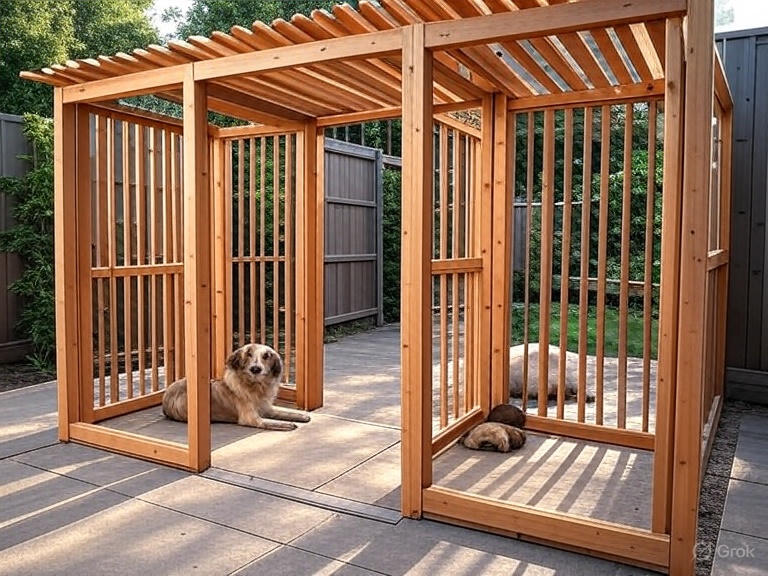How Big Should a Kennel Be for a Dog?
Choosing the right kennel size for your dog can feel overwhelming. You want your furry friend to feel comfortable and secure, but you also need to consider practical factors like space and budget. The truth is, selecting the perfect dog crate size depends on several key factors that many pet owners overlook.
Getting the kennel size wrong can lead to stress, anxiety, and behavioral problems in your dog. Too small, and your pet feels cramped and uncomfortable. Too large, and the kennel loses its den-like appeal that dogs naturally crave. This comprehensive guide will walk you through everything you need to know about sizing a kennel properly for your canine companion.
Understanding Your Dog’s Natural Instincts
Dogs descend from wolves, and they carry many ancestral behaviors that influence their preferences for enclosed spaces. Wild canines seek out dens for safety, warmth, and raising their young. Your domestic dog shares these same instincts, which explains why many dogs naturally gravitate toward small, enclosed spaces when they feel stressed or tired.
A properly sized kennel taps into these natural denning instincts. When you provide the right amount of space, your dog views the kennel as a safe haven rather than a prison. This psychological comfort translates into better behavior, reduced anxiety, and improved overall well-being.
The key lies in finding the sweet spot between too cramped and too spacious. Your dog should have enough room to perform essential movements while still feeling the security that comes from defined boundaries. This balance creates an environment where your pet can truly relax and recharge.
Essential Measurements for Kennel Sizing
Before you start shopping for a kennel, you need accurate measurements of your dog. Many pet owners skip this crucial step and end up purchasing the wrong size. Here’s exactly what you need to measure and how to do it correctly.
Length Measurement: Have your dog stand naturally and measure from the tip of their nose to the base of their tail. Don’t include the tail itself in this measurement. Add 4-6 inches to this number to determine the minimum kennel length. This extra space allows your dog to stretch out comfortably without touching both ends of the kennel.
Height Measurement: Measure your dog from the floor to the top of their head when sitting in a normal position. Some dogs hold their heads higher when alert, so you might want to take this measurement when your dog is relaxed. Add 4-6 inches to ensure your dog can sit and stand without bumping their head.
Width Considerations: While most kennels are designed with standard width proportions, consider your dog’s build. Broader dogs like Bulldogs need more width than slender breeds like Greyhounds, even if they’re the same length and height.
Weight Capacity: Don’t forget to check the kennel’s weight limit, especially for larger breeds. A kennel might have the right dimensions but lack the structural integrity to safely contain a heavy dog.
Size Requirements by Dog Breed Categories
Different dog breeds have vastly different space requirements, and understanding these categories helps you make a more informed decision. Rather than guessing, use these breed-specific guidelines to narrow down your options.
Toy Breeds (Under 25 pounds): Chihuahuas, Yorkies, and Maltese dogs typically need kennels measuring 24 inches long, 18 inches wide, and 21 inches high. These small dogs actually prefer cozier spaces and can feel lost in oversized kennels. A 24-inch kennel provides enough room for movement while maintaining that den-like feeling they crave.
Small Breeds (25-40 pounds): Breeds like Cocker Spaniels, Beagles, and French Bulldogs usually require 30-inch kennels. The dimensions typically measure 30 inches long, 21 inches wide, and 24 inches high. These dogs need more space to move around but still benefit from well-defined boundaries.
Medium Breeds (40-70 pounds): Golden Retrievers, Border Collies, and Bulldogs generally need 36-inch or 42-inch kennels, depending on their specific build. Standard dimensions range from 36x24x27 inches to 42x28x30 inches. Medium dogs often have more energy and need space to change positions comfortably.
Large Breeds (70-90 pounds): German Shepherds, Labrador Retrievers, and Rottweilers typically require 48-inch kennels measuring approximately 48x30x33 inches. These athletic dogs need room to stretch their long legs and turn around easily.
Extra Large Breeds (90+ pounds): Great Danes, Mastiffs, and Saint Bernards need 54-inch kennels or larger, with dimensions around 54x35x45 inches. Giant breeds require significant space due to their impressive size and longer limbs.
Indoor vs Outdoor Kennel Considerations
The location where you plan to use the kennel significantly impacts the size requirements and features you should prioritize. Indoor and outdoor environments present different challenges and opportunities for your dog’s comfort.
Indoor Kennel Spacing: Indoor kennels often need to fit into existing room layouts, which can limit your size options. However, indoor environments typically offer better temperature control and reduced stress factors. Your dog may feel comfortable in a slightly smaller indoor kennel because the overall environment feels safer and more controlled.
Consider the room’s acoustics when sizing an indoor kennel. Larger kennels in small rooms can create echo effects that some sensitive dogs find disturbing. Conversely, a well-sized kennel in a quiet room provides an ideal retreat space for your pet.
Outdoor Kennel Requirements: Outdoor kennels generally need to be larger than indoor alternatives because dogs spend extended periods in them. The outdoor environment also presents weather challenges that affect comfort levels. A dog confined outdoors needs space to move around to stay warm in cold weather and find comfortable positions in hot weather.
Outdoor kennels should include covered areas for shade and weather protection. This coverage area adds to the total space requirements, as your dog needs room to move between sunny and shaded areas based on their comfort preferences.
Ventilation and Airflow: Both indoor and outdoor kennels need proper ventilation, but outdoor kennels face more extreme conditions. Size impacts airflow patterns, with larger kennels generally providing better air circulation. However, overly large outdoor kennels in windy areas can become uncomfortable for your dog.
Special Considerations for Growing Puppies
Puppies present unique challenges when it comes to kennel sizing. You don’t want to buy multiple kennels as your puppy grows, but you also can’t start with an adult-sized kennel without consequences.
Adjustable Kennel Solutions: Many manufacturers offer kennels with adjustable dividers that allow you to modify the interior space as your puppy grows. Start with a section large enough for your puppy’s current size, then gradually expand the space as they mature. This approach provides the right den-like feeling while protecting your long-term investment.
Growth Rate Predictions: Research your puppy’s breed to understand their expected adult size and growth timeline. Some breeds reach full size by 12 months, while others continue growing until 18-24 months. Large breed puppies often experience rapid growth spurts that can catch owners off guard.
Housetraining Implications: Puppy kennel size directly impacts housetraining success. Too much space allows puppies to eliminate in one corner and sleep in another, which slows the housetraining process. The right size encourages bladder control because dogs naturally avoid soiling their sleeping area.
Safety During Growth: Growing puppies are more active and curious than adult dogs. Ensure the kennel size allows for safe movement without providing enough space for destructive behaviors. Young dogs can injure themselves trying to escape from inappropriately sized kennels.
Common Sizing Mistakes Pet Owners Make
Even well-intentioned dog owners frequently make kennel sizing errors that impact their pet’s comfort and the kennel’s effectiveness. Learning from these common mistakes can save you time, money, and frustration.
The “Room to Grow” Mistake: Many owners buy oversized kennels thinking their dog will appreciate extra space. While this seems logical, oversized kennels often fail to provide the security and comfort dogs seek. Dogs may refuse to use oversized kennels or develop anxiety when confined in spaces that feel too open.
Ignoring Breed-Specific Needs: Generic size charts don’t account for breed-specific body proportions and behaviors. A Greyhound and a Bulldog might weigh the same but need completely different kennel configurations. Greyhounds need length for their long legs, while Bulldogs need different proportions due to their compact, muscular build.
Measuring Incorrectly: Rushing through the measurement process leads to poor size choices. Some owners measure their dog lying down instead of standing, or they forget to account for the dog’s natural head position when sitting. These measurement errors can result in kennels that are too small for comfortable use.
Overlooking Door Size: The kennel door needs to be large enough for your dog to enter and exit comfortably. Some kennels have appropriately sized interiors but doors that are too small, creating stress during entry and exit. Your dog should be able to walk through the door in a natural position without ducking or squeezing.
Multi-Dog Household Considerations
Households with multiple dogs face additional complexity when choosing kennel sizes. Each dog needs their own space, but you also need to consider pack dynamics and available room in your home.
Individual vs Shared Spaces: While some bonded dogs enjoy sharing space, most dogs benefit from having their own individual kennels. Shared kennels can lead to resource guarding, territorial disputes, and stress. Even dogs that sleep together outside the kennel often prefer private spaces when confined.
Size Variations: Multiple dogs rarely need identical kennel sizes, even if they’re the same breed. Individual personalities, activity levels, and physical characteristics should influence each dog’s kennel size. Some dogs prefer cozier spaces, while others need more room to feel comfortable.
Placement Strategy: The location and spacing of multiple kennels affects how each dog responds to confinement. Dogs can become anxious if they can’t see their pack mates, but placing kennels too close together can create territorial tensions. Experiment with different arrangements to find what works best for your specific dogs.
Health and Mobility Considerations
Dogs with health issues, mobility problems, or age-related changes need special consideration when it comes to kennel sizing. What works for a healthy adult dog might not be appropriate for a senior dog or one recovering from surgery.
Senior Dog Needs: Older dogs often develop arthritis, hip dysplasia, or other mobility issues that affect their movement patterns. Senior dogs may need larger kennels to accommodate slower, more careful movements. They also benefit from kennels with lower entry thresholds and non-slip flooring surfaces.
Injury Recovery: Dogs recovering from surgery or injury often need modified kennel sizes to accommodate bandages, casts, or movement restrictions. Consult with your veterinarian about appropriate sizing during recovery periods. Some injuries require larger kennels to prevent re-injury, while others benefit from restricted movement in smaller spaces.
Chronic Conditions: Dogs with chronic conditions like hip dysplasia or spinal issues need kennels that accommodate their specific movement limitations. These dogs may need more space to change positions comfortably or specially configured kennels that reduce stress on affected joints.
Behavioral Factors That Influence Size Needs
Your dog’s personality and behavioral tendencies should influence kennel size decisions just as much as physical measurements. Some dogs thrive in cozy spaces, while others need more room to feel comfortable.
Anxiety-Prone Dogs: Dogs with anxiety often prefer smaller, more enclosed spaces that feel secure and den-like. Oversized kennels can actually increase anxiety in these dogs because they don’t provide the psychological comfort of defined boundaries. Anxious dogs may benefit from kennels with solid sides rather than wire construction.
High-Energy Breeds: Active breeds like Border Collies and Jack Russell Terriers may need slightly larger kennels to accommodate their tendency to move around more, even when confined. However, don’t make the kennel so large that it becomes a play area rather than a resting space.
Destructive Behaviors: Dogs with destructive tendencies need kennels sized to prevent damage while still providing comfort. Too much space can enable destructive behaviors, while too little space can increase frustration and anxiety that leads to destructive attempts to escape.
Climate and Environmental Factors
The climate where you live and the specific environment where you’ll place the kennel affects sizing decisions. Temperature, humidity, and seasonal changes all impact your dog’s comfort level in confined spaces.
Hot Climate Considerations: Dogs in hot climates need adequate space for air circulation and temperature regulation. Smaller kennels can become uncomfortably warm, while appropriately sized kennels with good ventilation help maintain comfortable temperatures. Consider kennels with elevated floors for better airflow in consistently hot environments.
Cold Weather Needs: Dogs in cold climates may actually prefer slightly smaller kennels that retain body heat more effectively. However, the kennel still needs enough space for comfortable movement. Some owners use removable bedding or kennel heaters to maintain warmth in larger kennels during cold seasons.
Seasonal Adjustments: Some dogs have different kennel preferences based on seasonal changes. A kennel size that works well in moderate weather might feel too small during hot summers when dogs want more space to stretch out, or too large during cold winters when they prefer cozier spaces.
Making the Final Decision
After considering all these factors, you’re ready to make an informed decision about kennel size. The perfect kennel size for your dog balances physical requirements, behavioral needs, and practical considerations for your specific situation.
Start with your dog’s physical measurements as the foundation, then adjust based on their personality, health status, and intended use. Remember that you can always add comfort items like beds, blankets, or toys to modify how the space feels to your dog, but you can’t change the basic dimensions once you’ve made your purchase.
Consider your long-term needs as well. If you’re likely to get another dog of similar size in the future, you might want to choose a kennel that could work for multiple pets. If your current dog is young and healthy, think about how aging might affect their needs over the kennel’s lifespan.
The right kennel size creates a positive experience for both you and your dog. Your pet should enter the kennel willingly and appear relaxed when confined. If your dog consistently resists using the kennel or shows signs of stress when confined, the size might not be appropriate for their needs.
Quality Over Size: While getting the right size is crucial, don’t forget about quality and safety features. A perfectly sized kennel that’s poorly constructed or unsafe won’t serve your dog well. Look for sturdy construction, secure latches, and smooth surfaces that won’t cause injury.
Trial Period: If possible, choose a retailer that offers a return policy or trial period. This allows you to test the kennel size with your dog and make adjustments if needed. Some dogs need time to adjust to a new kennel, so give your pet at least a week to settle in before deciding if the size is appropriate.
Selecting the right kennel size is an investment in your dog’s comfort, safety, and overall well-being. Take the time to measure carefully, consider all relevant factors, and choose based on your dog’s individual needs rather than generic recommendations. With the right size kennel, you’ll provide your furry friend with a safe haven they’ll appreciate for years to come.







